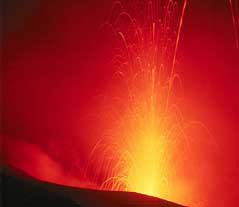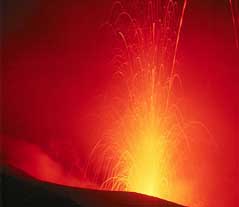 Italy is a small country, and yet it contains all types of volcanoes that can be found in other areas of the world at distances of thousands of kilometers. Southern Italy, in particular, is like an enormous pressure cooker, with its three main volcanoes. Stromboli, Etna and Vesuvius are the most famous active volcanoes on Earth. The reason of this high concentration of volcanoes is that Italy corresponds to the collision point of European and African continental plates.
Italy is a small country, and yet it contains all types of volcanoes that can be found in other areas of the world at distances of thousands of kilometers. Southern Italy, in particular, is like an enormous pressure cooker, with its three main volcanoes. Stromboli, Etna and Vesuvius are the most famous active volcanoes on Earth. The reason of this high concentration of volcanoes is that Italy corresponds to the collision point of European and African continental plates.
The largest and one of the most active volcanoes in Europe is Mount Etna, that lies near the eastern coast of Sicily and it is considered a benign volcano. It is called the “good volcano” or the “beautiful mountain”. The volcanic soil is very fertile and supports extensive agriculture, with vineyards spread across the lower slopes of the mountain. The climate there is favorable, as it is conditioned by the presence of a large mountain close to the sea. Etna’s main feature is the voluminous lava emission. Strong explosive activity occurs rarely, usually from its four summit craters. They are spectacular, but they are not a threat for the inhabited areas. Other eruptions occur on the flanks, where there are more than 300 vents, ranging in size from small holes in the ground to large craters. Flank eruptions can occur down to a few hundred meters altitude, close to the populated areas. Numerous villages and small towns lie around or on cones of past flank eruptions. Etna reaches 3000 meters and covers an area of 1200 square miles. It is possible to have a tour around Mount Etna, and even to climb to the top. Of course, this is a breathtaking experience and in the warmest months of the year you will find yourself in a lunar-desert scene, with sulfurous fumes and thick vapors. A bus leaves from Catania early in the morning, then a cable car and 4 wheel drive truck will take you up to the top.
The second volcano I would like to talk about is Vesuvius, about 5.6 mi east of Naples. Vesuvius, in AD 79, destroyed and completely buried the town of Pompeii. The drama has inspired the fantasies of generations of poets, philosophers and scientists. The eruption buried Pompeii underneath 22 meters of ash and it was lost for nearly 1,600 years before it was accidentally rediscovered in 1592. Since then, its excavation has provided an extraordinarily detailed insight into the life of a city at the height of the Roman Empire. Pompeii has been a popular tourist destination for 250 years; it was even on the Grand Tour. Visiting the excavations of Pompeii provides a lifetime experience. Lava flows and mud covered the town preserving it from aging until a couple of centuries ago, when archaeologists began to unveil the beauty of the large Roman town with a flourishing economy and about 20,000 inhabitants.
The Roman naturalist and philosopher Pliny the Elder described the eruption with abundance of particulars. He found particularly frightening the long and deep darkness during daytime, as consequence of the ashes. This is the first accurate account of an eruption in the history of mankind. It is thought to have lasted about 19 hours.
Stromboli is another must for volcanoes lovers. Because of its position in the sea north of Sicily and its constant activity, it has the nickname of “lighthouse of the Mediterranean Sea.” The volcano has erupted many times, and is constantly active with major eruptions, often visible from many points on the island and from the surrounding sea. Most of this activity is of a very moderate size, consisting of brief and small bursts of glowing lava fragments to heights of rarely more than 150 m above the vents. It is one of the islands which form the Aeolian archipelago. It is possible to take part to guided tours to climb the volcano at night. You will see dozens of cruise ships and sail boats anchored not too far from the island. Night is surely the best time to visit the volcano because that's when you can enjoy the flaming color of magma. In the silence, the sound of rocks bursting out of the vents and rolling down into the sea resembles that of fireworks.

